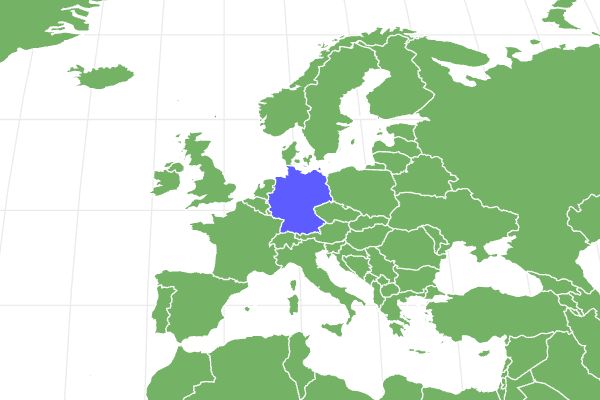Great Dane
Canis lupus
Large and imposing in appearance!
Advertisement
Great Dane Scientific Classification
- Kingdom
- Animalia
- Phylum
- Chordata
- Class
- Mammalia
- Order
- Carnivora
- Family
- Canidae
- Genus
- Canis
- Scientific Name
- Canis lupus
Read our Complete Guide to Classification of Animals.
Great Dane Conservation Status
Great Dane Facts
Great Dane as a Pet:
- General Health
- Energy Level
- Shedability
- Trainability
- Intelligence
- Tendency to Chew
- Size
- Family and kid friendliness
- Yappiness / Barking
- Moderate
- Separation Anxiety
- Moderate
- Preferred Temperature
- Average climate
- Exercise Needs
- Moderate
- Friendly With Other Dogs
- Moderate
- Pure bred cost to own
- $600 to $3,000
- Dog group
- Working
- Male weight
- 110-175 lbs
- Female weight
- 100-130 lbs
This post may contain affiliate links to our partners like Chewy, Amazon, and others. Purchasing through these helps us further the A-Z Animals mission to educate about the world's species.
View all of the Great Dane images!
Sometimes called “the Apollo of Dogs,” Great Danes are a giant German working breed that was originally developed by German nobles as a boarhound.
Ranking at number 16 on the American Kennel Club’s most popular list, these gentle giants will steal your heart as well as your sofa. They have short, smooth coats that come in a variety of colors, including fawn, brindle, steel blue, black, mantle, harlequin, and merle. This breed only requires moderate daily exercise, but due to their size, they do need space. Unfortunately, that size makes them ill-suited for apartment living; they won’t have enough room.
See all of our expert product reviews.
Great Danes are well-known for their affectionate and gentle nature. They get along famously with children and other animals, which makes them excellent family pets.
You can check out more incredible facts about Great Danes.
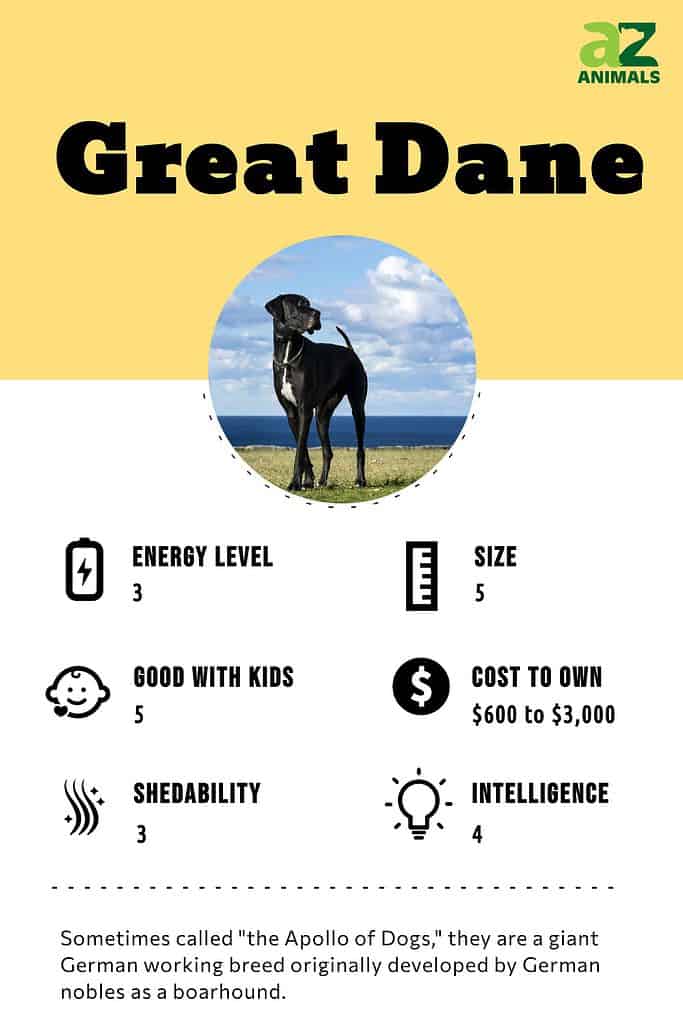
3 Pros and Cons of Ownership
| Pros! | Cons! |
|---|---|
| They are easygoing and affectionate Great Danes are well-known for their easygoing and affectionate nature, which makes them wonderful family pets. | They drool a lot Given their size, it’s not exactly surprising that Great Danes tend to drool excessively. If you choose to own this breed, you should expect that your clothes, furniture, and floors will all end up covered in drool at some point. |
| They only require moderate exercise Unlike most other large and giant breeds, Great Danes only require moderate daily exercise. They will be quite happy with a daily walk or game of fetch in the backyard. | They take up a lot of space Great Danes can weigh as much as the average man and will easily take up an entire sofa when they lie down. If you live in a small apartment, this is not the right breed for you. |
| They are easy to train Great Danes are eager to please their masters, which makes training a breeze. | They have a short lifespan As with all giant breeds, the life expectancy of a Great Dane is unfortunately short. They only live for an average of 8 to 10 years. |
Size and Weight
On average, Great Danes can weigh anywhere from 110 pounds to 175 pounds and stand between 28 and 32 inches high at the shoulder. The males of this breed tend to be slightly taller than the females. Learn more about the best big dog breeds here.
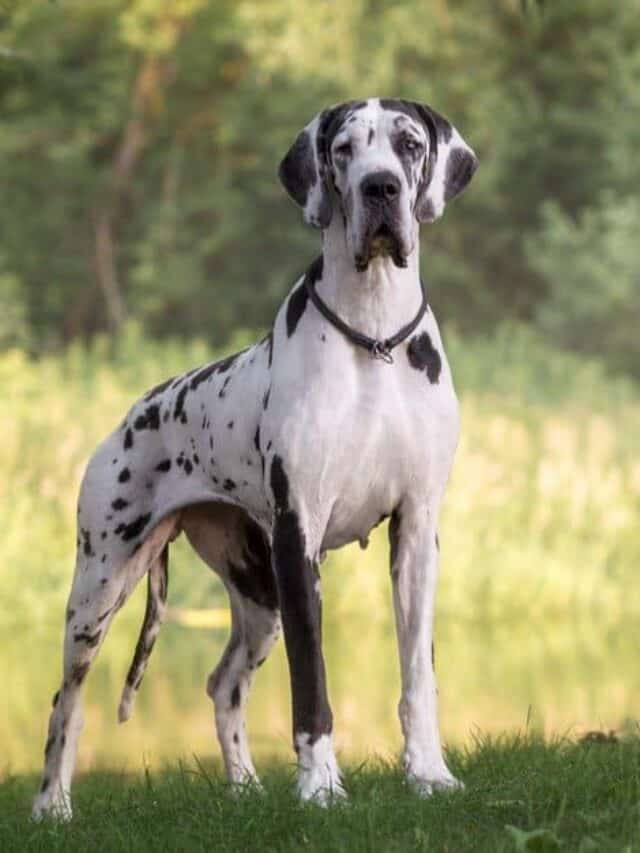
On average, Great Danes can weigh anywhere from 110 pounds to 175 pounds and stand between 28 and 32 inches high at the shoulder.
©Al_Er/Shutterstock.com
Health and Entertainment for your Great Dane
See all of our expert product reviews.
Types of Great Danes
American vs. European
There is little difference in height between these two breeds. American Great Danes are distinguished by their long, graceful, and sleek appearance, which gives them the appearance of being taller. Great Danes range in height from 30 to 34 inches. Females stand between 28 and 32 inches tall.
Weight is one point at which the two diverge. American Great Danes are slightly smaller in stature than their European counterparts, weighing between 99 and 200 pounds depending on gender and maturity. European Great Danes are even larger and more muscular than American Great Danes. When completely mature, Great Danes in Europe can weigh between 180 and 240 pounds!
Read more here about these two Great Danes!
7 Different Colors, Coats, and Patterns for This Breed
- Harlequin – Harlequin Great Danes have a great, random, modern art style look to their white base fur coat with black splotches.
- Black – Black Great Danes have a beautifully rich, black coloration to their fur and must be black throughout their bodies to meet AKC registration.
- Merle – Merle Great Danes are similar to Harlequins except that their “undercoat” is more of a grey instead of white.
- Brindle – Brindle Great Danes, much like other brindle-colored breeds, are a mix-match of colors and patterns, yet they do have a fawn coloration underneath their fur.
- Blue – Blue Great Danes have regal coats that range from light to dark grey. Ideally, they will have no other colors on their fur.
- Fawn – Fawn Great Danes are the most common of the breed. They have a tan color across their whole body except for a darker “mask” on their face.
- Mantle – Mantle Great Danes have consistent markings across their body that consist of a black base coat and white on their feet, face, and chest.
Origin and History
Although the name Great Dane fools a lot of people, these dogs actually originated from Germany, all the way back to the 1500s. They were a combination of Irish Wolfhounds and English Mastiffs, plus other similar big canines. The goal was to produce dogs that could hunt the largest game animals and for protection. Their great size was enough to get the job done.
It is guessed that avoiding using the word German in the name of this breed, due to the connection of Germany to the world wars, was a marketing choice to help “sell” the breed to Europe and America.
Common Health Issues
The number one health issue that Great Danes face is gastric dilatation-volvulus, more commonly known as bloat. Owners should take safety measures to reduce the chances of bloat. They should also familiarize themselves with the symptoms of bloating and what to do if it occurs.
Great Danes may fall victim to conditions such as diseases involving their heart, eyes, or thyroid, and hip or elbow dysplasia.
Temperament
Despite their intimidating appearance, Great Danes are one of the friendliest dog breeds in the world. They are also remarkably gentle with children, and their eagerness to please their masters makes them a joy to train. They are quite affectionate with their families and hate being left alone, so if you spend a lot of time out of the house and can’t take your dog with you, this is not the breed for you. When left to their own devices for too long, they can become quite destructive. That’s not good for any dog, but destructiveness in a dog of this size is a homeowner’s worst nightmare.
Due to their social nature, these dogs are excellent with other pets and children, making them wonderful family dogs. Just be aware that despite their size, they often decide that they are lap dogs. If you’re not prepared to share your couch with your giant pup, you may want to consider a different breed.
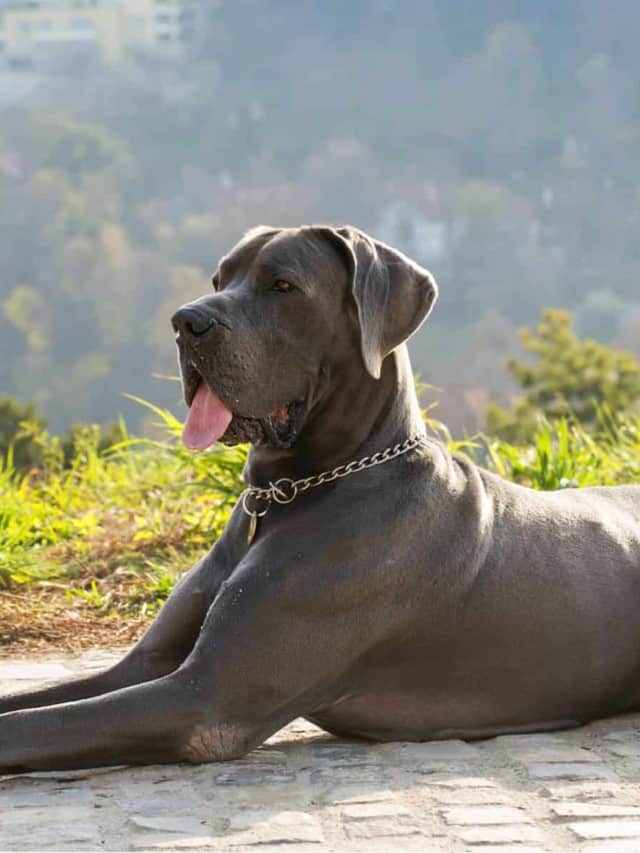
Just be aware that despite their size, they often decide that they are lap dogs!
©belu gheorghe/Shutterstock.com
How To Take Care of One
Due to their size and the nature of their breed, owners should put together a strict feeding and exercise routine. Beyond that, the Great Dane is a generally maintenance-free breed, needing only moderate daily exercise and casual grooming. Since adults of this breed can easily outgrow their owners, it’s important to start obedience training early. It’s much easier to teach a 60-pound pup good manners than it is to re-train an unruly 150-pound adult.
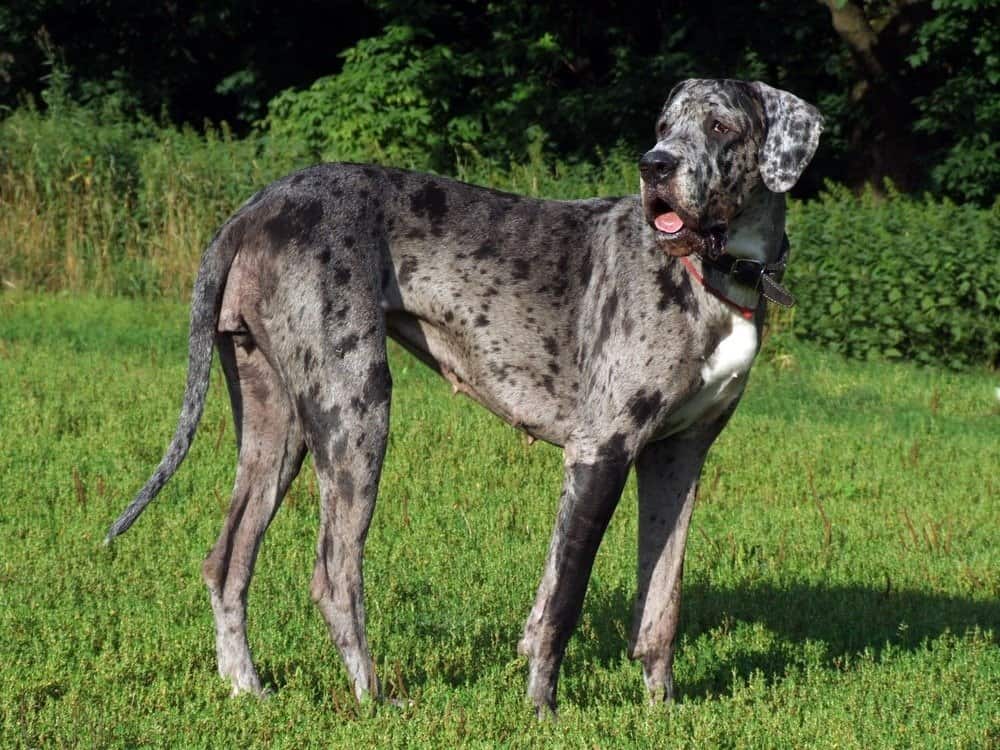
Great Danes are a generally maintenance-free breed, needing only moderate daily exercise and casual grooming.
©velora/Shutterstock.com
The Best Dog Food
Great Danes should only eat high-quality food specially formulated for giant breeds. Owners should only allow these dogs to eat human food sparingly and use caution in choosing which foods they receive. The number one killer of this breed is bloat, so taking care of a feeding routine is of the utmost importance. To lower the chances of bloating, be sure to feed your Great Dane multiple small meals each day, use a food dish that forces slower eating, keep food and water in raised dishes, and limit exercise before and after meals.
Great Danes are one of those giant breeds with big, loving hearts that can, unfortunately, struggle to support that much dog. Therefore, due to the link between heart failure and legumes in dog food, Great Dane owners may want to look into the benefits of legume-free dog food.
So, A-Z Animals thinks the best dog food to give to Great Danes is Nutro Ultra Large Breed Adult Dry Dog Food.
This food stays away from those questionable legume ingredients such as peas, lentils, and chickpeas. Instead, there’s just complete, wholesome nutrition. For example, this food has not one but two high-quality protein sources, chicken and lamb, that fortify the large dog formula with extra glucosamine and chondroitin sulfate to nourish your Great Dane’s joints. This food is also rich in amino acids that aid Great Dane’s sensitive digestion.
Check Chewy or Amazon for this product.
- Lamb and brown rice recipe for large dog breeds
- Contains glucosamine and chondroitin to support healthy joints
- Antioxidants for immune health
Best Insurance
Since most pet insurance companies don’t cover pre-existing conditions and Great Danes are prone to quite a few health problems, it’s a good idea to get health coverage for them at an early age. Since bloat is so common in this breed, it’s more important than ever to have coverage for an emergency situation.
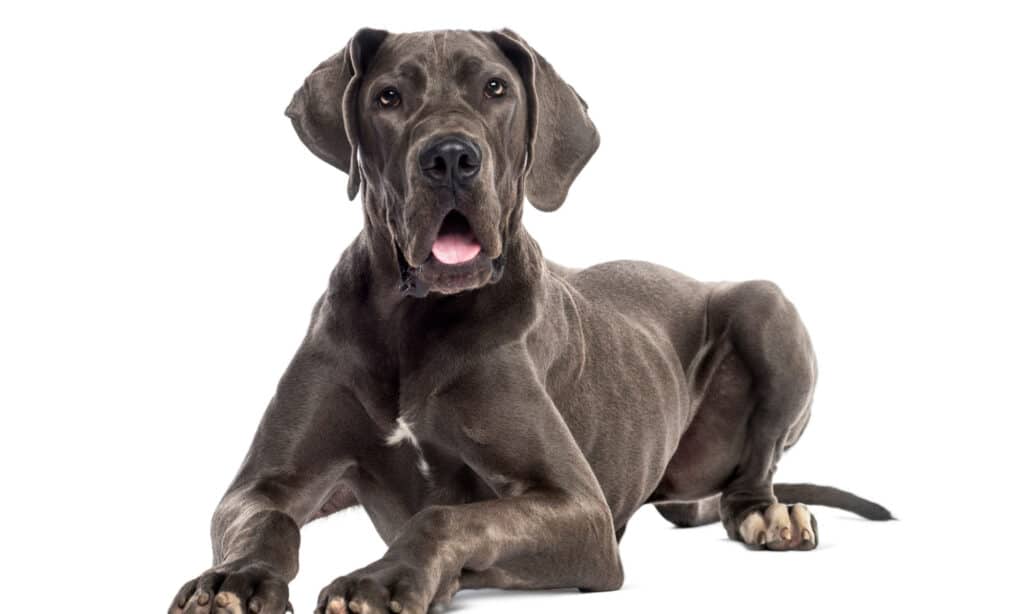
Great Danes cost more to insure because they’re prone to certain health issues.
©iStock.com/GlobalP
Maintenance and Grooming
Great Danes don’t shed too much throughout most of the year, so weekly brushing is enough to keep hair fall to a minimum. They do, however, have seasonal shedding cycles twice each year, during which time they will need daily brushing to keep your home from getting covered in dog hair. They are not an overly dirty breed, so they will only need bathing a few times each year. Outside of brushing and bathing, the only maintenance a Great Dane needs is frequent tooth brushing and ear cleaning, as well as monthly nail trimming.

Great Danes do have seasonal shedding cycles twice each year, during which time they will need daily brushing to keep your home from getting covered in dog hair
©RugliG/Shutterstock.com
Training
Due to the Great Dane’s massive adult size, early training, and socialization are imperative. This breed is friendly and loves to please his master, so with gentle and consistent guidance, he will excel at obedience training.
Exercise
Despite their size, Great Danes are not overly active dogs. The only exercise they need is a daily walk or a nice game of fetch in the backyard. When they are older, they can make great hiking or jogging companions, but activities of this nature should wait until your dog reaches at least two years old so that they don’t put too much strain on growing bones and joints.
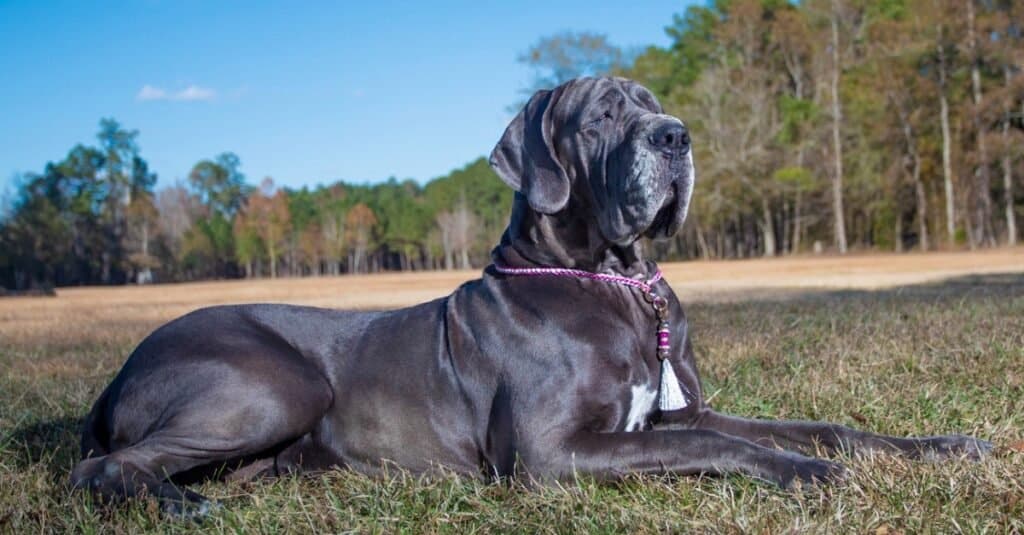
Despite their size, Great Danes are not overly active dogs.
©iStock.com/gsagi
Puppies
Like all breeds, Great Dane puppies are full of energy and need constant care and attention. Since this breed gets so big when fully grown, it’s a good idea to start obedience training and socialization early. These dogs are eager to please and highly sociable, so gentle and consistent training will make these pups into model citizens in no time.
As with other giant breeds, you should take care when playing with your Great Dane pup. Since vigorous activity can put a lot of strain on growing bones and joints, you shouldn’t let your puppy jump or participate in high-impact activities like jogging until they are about two years old.
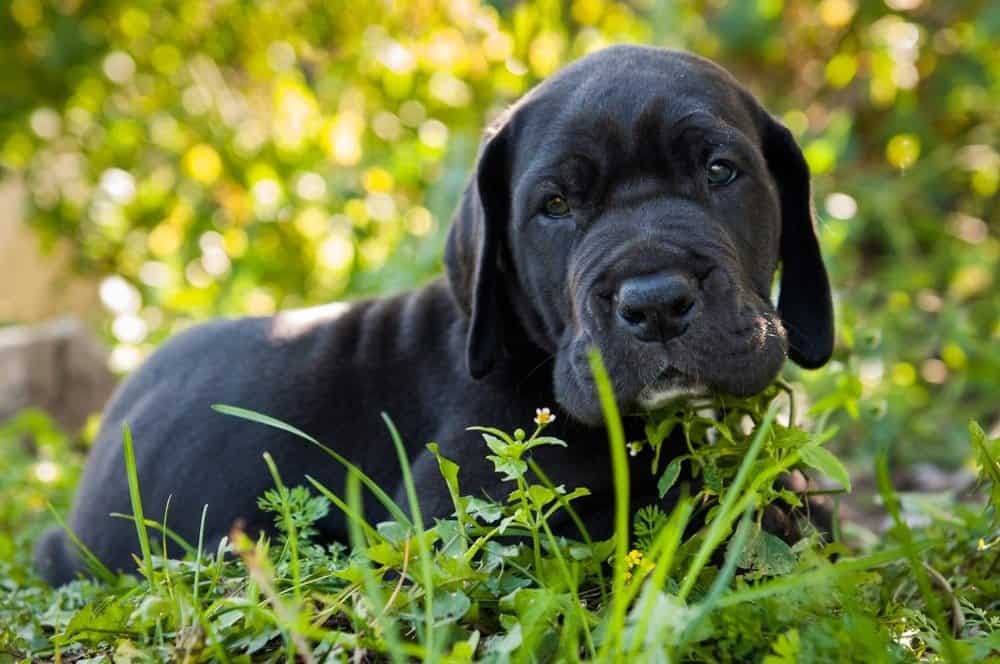
Since this breed gets so big when fully grown, it’s a good idea to start obedience training and socialization early.
©Zanna Pesnina/Shutterstock.com
With Children
Despite their hulking size, Great Danes are one of the most gentle and affectionate breeds in the world, which makes them ideal companions for children of all ages. They do often forget how big they are, which means they can accidentally knock over or crush a small child. Owners should take care of teaching their Great Danes how to interact politely with little ones while they are puppies to reduce accidental injuries, and should never leave dogs and children unsupervised.

Great Danes are among the most gentle and affectionate breeds in the world, making them ideal companions for children of all ages; however, they do often forget how big they are, which means they can accidentally knock over or crush a small child.
©Claire Plumridge/Shutterstock.com
Similar Dogs
If you’d like a dog that’s similar in size or personality to the Great Dane, here are a few breeds to check out.
- Mastiff
Mastiffs are roughly the same size as Great Danes and are just as easy to train. - Doberman Pinscher
Doberman Pinschers are a good deal smaller than Great Danes and are a more athletic breed. - Bullmastiff
Bullmastiffs are slightly smaller than Great Danes and equally affectionate family dogs.
Famous Examples
Though there’s not much record of famous Great Danes in real life, this breed has been quite popular in the fictional world of cartoons. The three most popular Great Danes in TV history are Astro from the Jetsons, Marmaduke from the Sunday paper comic strip of the same name, and Scooby-Doo.
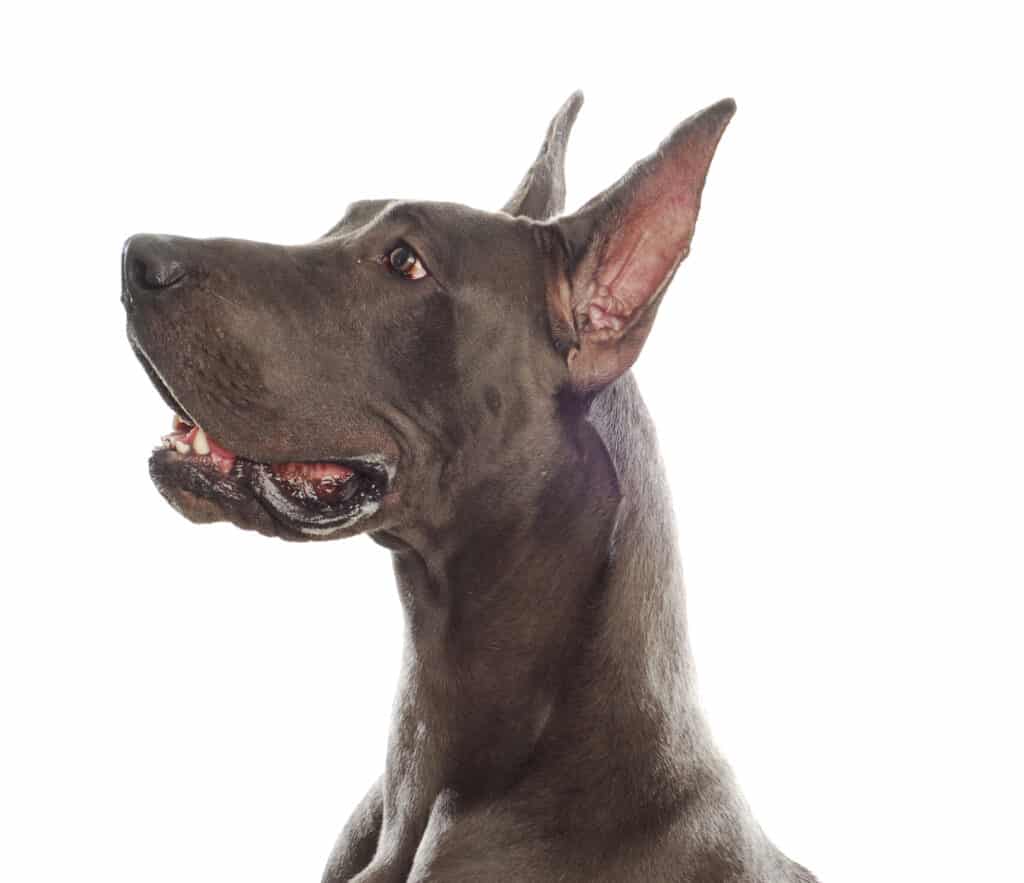
There are several Great Danes in famous cartoons and TV shows!
©WilleeCole Photography/Shutterstock.com
Popular Names for Great Danes
A few popular names for Great Danes include:
- Duke
- Tank
- Apollo
- Brutus
- Samson
- Maxi
- Olympia
- Harley
- Dakota
- Ursa
Great Dane FAQs (Frequently Asked Questions)
How tall is a Great Dane?
The average Great Dane stands between 28 and 32 inches tall at the shoulder.
How much does a Great Dane weigh?
On average, Great Danes weigh between 110 and 175 pounds.
How fast can a Great Dane run?
Great Danes can reach top speeds of up to 30 miles per hour.
Are Great Danes good pets?
Yes. Great Danes have a gentle and affectionate nature and are incredibly social creatures that can get along well with humans and other animals, making them excellent family pets.
Are Great Danes dangerous?
No. Although they may look imposing, properly socialized Great Danes are gentle giants who are friendly with everyone they meet.
What is the difference between a merle and a harlequin Great Dane?
The only difference between merle and harlequin Great Danes is the markings on their coat. Harlequins are white with black markings, while merles are dapple grey with black markings. Merle coats often occur when two harlequins are bred together.
Are Great Danes herbivores, carnivores, or omnivores?
Great Danes are Omnivores, meaning they eat both plants and other animals.
What Kingdom do Great Danes belong to?
Great Danes belong to the Kingdom Animalia.
What class do Great Danes belong to?
Great Danes belong to the class Mammalia.
What phylum to Great Danes belong to?
Great Danes belong to the phylum Chordata.
What family do Great Danes belong to?
Great Danes belong to the family Canidae.
What order do Great Danes belong to?
Great Danes belong to the order Carnivora.
What type of covering do Great Danes have?
Great Danes are covered in Hair.
What genus do Great Danes belong to?
Great Danes belong to the genus Canis.
What is an interesting fact about Great Danes?
Great Danes are large and imposing in appearance!
What is the scientific name for the Great Dane?
The scientific name for the Great Dane is Canis lupus.
What is the lifespan of a Great Dane?
Great Danes can live for 7 years.
What is the difference between a Great Dane vs Greyhound?
There are many differences between a Greyhound and a Great Dane. The Great Dane grows much heavier than the average Greyhound, while Greyhounds have a longer lifespan than Great Danes do.
What are the differences between a Dalmatian and a Great Dane?
The key differences between Dalmatians and Great Danes are size, appearance, temperament, and life expectancy. Although Dalmatians and Great Danes share a similar build, both breeds are easily distinguishable. These two breeds do not belong to the same breed group and have numerous variances. Dalmatians, for example, belong to the non-sporting group, but Great Danes belong to the working group.
What are the differences between a Great Dane and a Mastiff?
The major differences between the Great Dane and the English Mastiff are their size, temperament, health condition, and appearance. Their position on the gigantic spectrum is another reason to mention. For example, the Great Dane is a very tall and long dog, but the English Mastiff is very broad.
What are the differences between an Irish Wolfhound and a Great Dane?
The key differences between the Irish Wolfhound and the Great Dane are appearance, size, health risk, and temperament. Great Danes are frequently larger dogs, although Irish wolfhounds generally are taller.
Although the Irish Wolfhound originated in Ireland and the Great Dane originated in Germany, most experts say that the Great Dane’s genealogy is a cross between the English Mastiff and the Irish Wolfhound.
What are the key differences between Great Danes and Dobermans?
The key differences between Great Danes and Dobermans are appearance, characteristics, and health factors.
What's the difference between an American and a European Great Dane?
There are many differences between American and European Great Danes, including their weights, lifespans, and behaviors.
What's the difference between the Great Dane and the Weimaraner?
The Great Dane is larger than the Weimaraner, though the Weimaraner lives a longer lifespan compared to the average Great Dane. Additionally, the Great Dane requires less exercise than the energetic Weimaraner.
What are the key differences between Catahoula Leopard Dogs and Great Danes?
The key differences between Catahoula Leopard Dogs and Great Danes are origin, appearance, lifespan, temperament, trainability, and grooming.
What is the key difference between Great Dane and St Bernard?
The key difference between a St. Bernard and a Great Dane is appearance. Other differences include size, lifespan, temperament, energy level, grooming requirements, drooling, and barking.
Thank you for reading! Have some feedback for us? Contact the AZ Animals editorial team.
Sources
- David Burnie, Dorling Kindersley (2011) Animal, The Definitive Visual Guide To The World's Wildlife
- Tom Jackson, Lorenz Books (2007) The World Encyclopedia Of Animals
- David Burnie, Kingfisher (2011) The Kingfisher Animal Encyclopedia
- David Burnie, Dorling Kindersley (2008) Illustrated Encyclopedia Of Animals
- Dorling Kindersley (2006) Dorling Kindersley Encyclopedia Of Animals
- American kennel Club, Available here: https://www.akc.org/dog-breeds/great-dane/
- Great Dane Care, Available here: https://greatdanecare.com/are-great-danes-good-with-kids/

